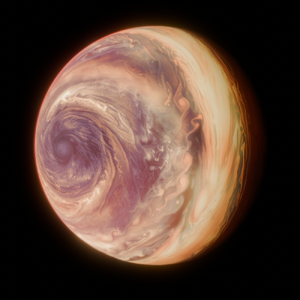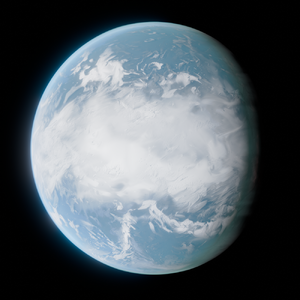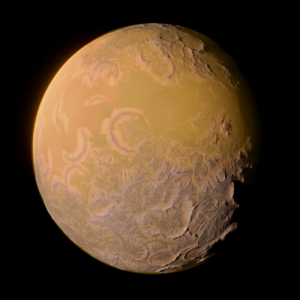Astronomy: Difference between revisions
(→Alir) |
|||
| Line 77: | Line 77: | ||
== Tyr - The System's Giant == | == Tyr - The System's Giant == | ||
Tyr, the enigmatic brown dwarf, traverses our skies in an eccentric ballet, its celestial path an age-old tale of duality, woven with threads of both boon and bane. From the surface of Gotha, during the Tyrian Maximum, Tyr stands as a luminous orb, larger and brighter than the most brilliant stars, yet dimmer than our vermillion coloured moon Hela. Despite its dwarf status, its deep molten orange, sometimes leaning toward reddish or magenta hues, lends the sky an ethereal quality, especially during the twilight hours. The dwarf's radiant heat intensifies the hues of sunrises and sunsets, painting the horizon with a palette of colours that have inspired countless Gothan poets and artists. | |||
Every 36 years, as if bound by an ancient cosmic clock, Tyr draws close, casting its subtle but profound influence upon Gotha's delicate climate. During this Tyrian Maximum, Tyr's gravitational pull and subtle radiative effects combine to nudge Gotha's temperatures upward by a seemingly slight 2 degrees. In certain regions, clouds shift, rains become generous, and the land burgeons with life. Crops grow taller, fruits bear sweeter, and for a time, it's as if nature itself celebrates. | |||
However, the dance of the cosmos is one of balance. As some regions revel in abundance, others face the brunt of Tyr's embrace. Rain clouds recede, rivers run thin, and parched lands stretch far and wide. Communities come together, finding ingenious ways to survive and adapt to these testing times. | |||
Conversely, the Tyrian Minimum brings a change in Tyr's luminance. Its brightness diminishes, though it remains a distinctive presence in the sky due to its unique colour and brilliance. As Tyr retreats on its elliptical path, Gotha feels a drop in temperature, again by that crucial 2-degree mark. Areas once stricken by drought find relief in cooler breezes and timely rains. Yet, elsewhere, the cold proves a challenge. | |||
Tyr, in its cosmic journey, serves as a reminder of the delicate balance that governs life. Its cycles, though predictable, challenge the adaptability of Gotha's inhabitants, pushing them to innovate, unite, and cherish the ebb and flow of nature's ever-changing embrace. | |||
{| class=wikitable style="margin-left: auto; margin-right: auto; width:20%; text-align:center;" | {| class=wikitable style="margin-left: auto; margin-right: auto; width:20%; text-align:center;" | ||
! Celestial Body !! Tyr | ! Celestial Body !! Tyr | ||
Revision as of 04:46, 22 August 2023
Constellations of the Gothan Night Sky
The vast expanse of the night sky has long captivated the human imagination. From the primitive civilizations of yore to today's advanced societies, one consistent practice stands out – the grouping of stars into recognizable patterns, known as constellations. However, this practice isn't merely about observing the sky. The significance of constellations lies in their rich history and their reflection of human culture, beliefs, and myths.
Origins in Antiquity
The partitioning of the starry expanse into specific regions, each marked by a set of stars, is a practice that dates back to ancient times. The origin of both the patterns and names attributed to these constellations is believed to lie in the systems prevalent among primitive civilizations. The ways in which stars were grouped and named provides valuable insights into the meteorological, religious, and mythological beliefs of these early societies.
From Constellations to Asterisms
While the larger star patterns are referred to as constellations, there exists a subset known as asterisms. These are smaller groups of stars that are part of larger constellations. Just like constellations, asterisms, as well as individual stars, have been given names throughout history. Often, these names echo meteorological phenomena or encapsulate the religious and mythological beliefs of the societies that named them.
Alir
Alir, the luminous heart of our cosmic domain, reigns supreme in its fiery splendour. An ever-burning beacon, it casts its radiant embrace across the vast celestial tapestry, bringing warmth, light, and life to the farthest reaches of its dominion. Each day, Alir rises, not just as a star but as an emblem of hope, continuity, and the undying spirit of the cosmos.
Its fiery visage, a cauldron of churning plasma and magnetic storms, paints the sky with hues of gold and crimson, manifesting both the gentleness of dawn and the fury of a solar flare. Alir's power is not just the visible brilliance that meets the eye; its influence stretches far and wide, its gravitational embrace holding planets, moons, and asteroids in a harmonious cosmic ballet.
Yet, for all its blazing might, Alir is also a beacon of life. It is the architect of life on Gotha, the whisper of evening winds on Nemon, and the touch of warmth that fights Roth's icy chill. Its rays penetrate the deepest oceans of Samler and dance upon the stormy face of Numor.
It's said that every flare, every sunspot, tells a tale older than the planets themselves—a chronicle of creation, evolution, and the eternal cycle of birth and rebirth. As Alir continues its aeons-long journey, it remains a testament to the beauty and power of nature, a reminder of our humble place within the grand theatre of the universe.
| Star | Alir |
|---|---|
| Class | G-type Main Sequence Star (G2V) |
| Mass (Earth masses) | 333,000 |
| Radius (km) | 696,340 |
| Rotation Period (hours) | Approximately 609.12 (at the equator) |
| Ocean Data | N/A |
| Orbital Data (Period) | N/A |
| Semi-major Axis (AU) | N/A |
| Eccentricity | N/A |
| Axial tilt | Approximately 7.25° (to the ecliptic) |
| Inclination (°) | N/A |
| Max temperature (°C) | Approximately 15 million (at the core) |
| Average Temperature (°C) | Approximately 5,500 (surface) |
| Min Temperature (°C) | Approximately 4,000 (in sunspots on the surface) |
Alirian Inner System
Numor, often dubbed as the "Vigilant Eye of Tyr," stands sentinel as the innermost celestial body of its system. This tidally locked sub-gas giant boasts an awe-inspiring sun-facing vortex within its gas clouds, granting it the appearance of an enormous, watchful amber eye forever fixed on Tyr. Both observational data and prevailing theories paint a portrait of a planet fraught with peril. Furious, tempestuous winds roar through its atmosphere with such violence that they threaten to obliterate any probe that isn't first consumed by the searing heat of Numor's sunlit side. Conversely, the eternal night of its dark side plunges temperatures well below freezing. This extreme thermal dichotomy suggests the potential for an intricate tapestry of atmospheric reactions, with the planet's distinctive cloud bands possibly serving as testament to its exotic chemistry.
Samler is an enigma of a world, sheathed entirely in a vast, boundless ocean. Beneath its azure depths, the ocean floor is believed to be blanketed by a dense layer of high-pressure ice. This unique ice layer acts as a protective barrier, insulating the warm, pulsating heart of the planet from its rocky foundation. Despite Samler's soaring temperatures, its thick and oppressive atmosphere staunchly prevents its waters from vaporizing into space. While its unforgiving conditions and deep, scalding oceans might initially suggest a barren world, it's pivotal to approach such claims with caution.
Nemon, cloaked in tales of ancient cosmic dance, may have once been tethered to Samler as its steadfast moon. But the gravitational whims of Alir and Tyr severed this bond, propelling Nemon into an independent orbit. Resembling a tamer version of Gotha, this diminutive, low-gravity planet offers warmer climes, punctuated by sparse traces of water vapor. High altitudes might see these vapors condense into fleeting droplets before they are swiftly reclaimed by the heat. Yet, hope flickers in the hearts of many, as the tantalizing prospect of life on Nemon remains a beacon of possibility.
Gotha, our cradle of life, blossoms as a verdant oasis amidst the vastness of space. Its lush landscapes and teeming oceans brim with life, nurturing and sustaining every breath we take.
Roth stands in stark contrast as a frigid, rocky realm, smaller than Gotha. Its surface is a mosaic of icy sheets and snowdrifts, punctuated occasionally by steam or carbon dioxide geysers that mark sites of geological unrest. The juxtaposition of its pristine white expanse against streaks of earthy brown entices many a curious mind. Deep beneath its cold facade, there might be sanctuaries of liquid water, cradling pockets of life that persist against all odds.
|
|---|
Tyr - The System's Giant
Tyr, the enigmatic brown dwarf, traverses our skies in an eccentric ballet, its celestial path an age-old tale of duality, woven with threads of both boon and bane. From the surface of Gotha, during the Tyrian Maximum, Tyr stands as a luminous orb, larger and brighter than the most brilliant stars, yet dimmer than our vermillion coloured moon Hela. Despite its dwarf status, its deep molten orange, sometimes leaning toward reddish or magenta hues, lends the sky an ethereal quality, especially during the twilight hours. The dwarf's radiant heat intensifies the hues of sunrises and sunsets, painting the horizon with a palette of colours that have inspired countless Gothan poets and artists.
Every 36 years, as if bound by an ancient cosmic clock, Tyr draws close, casting its subtle but profound influence upon Gotha's delicate climate. During this Tyrian Maximum, Tyr's gravitational pull and subtle radiative effects combine to nudge Gotha's temperatures upward by a seemingly slight 2 degrees. In certain regions, clouds shift, rains become generous, and the land burgeons with life. Crops grow taller, fruits bear sweeter, and for a time, it's as if nature itself celebrates.
However, the dance of the cosmos is one of balance. As some regions revel in abundance, others face the brunt of Tyr's embrace. Rain clouds recede, rivers run thin, and parched lands stretch far and wide. Communities come together, finding ingenious ways to survive and adapt to these testing times.
Conversely, the Tyrian Minimum brings a change in Tyr's luminance. Its brightness diminishes, though it remains a distinctive presence in the sky due to its unique colour and brilliance. As Tyr retreats on its elliptical path, Gotha feels a drop in temperature, again by that crucial 2-degree mark. Areas once stricken by drought find relief in cooler breezes and timely rains. Yet, elsewhere, the cold proves a challenge.
Tyr, in its cosmic journey, serves as a reminder of the delicate balance that governs life. Its cycles, though predictable, challenge the adaptability of Gotha's inhabitants, pushing them to innovate, unite, and cherish the ebb and flow of nature's ever-changing embrace.
| Celestial Body | Tyr |
|---|---|
| Class | Brown Dwarf |
| Mass (Earth masses) | 17776.00 |
| Radius (km) | 56473.00 |
| Rotation Period (hours) | 90.20 |
| Ocean Data | N/A |
| Orbital Data (Period) | 36.1 years |
| Semi-major Axis (AU) | 11.10 |
| Eccentricity | 0.35 |
| Axial tilt | 0.00 |
| Inclination (°) | 0.00 |
| Max temperature | 727.00 |
| Average Temperature | 727.00 |
| Min Temperature | 727.00 |
Alirian Outer System
|
|---|


